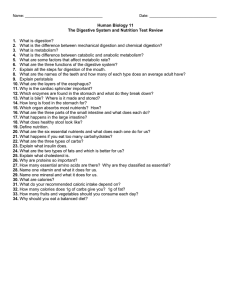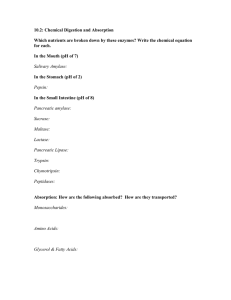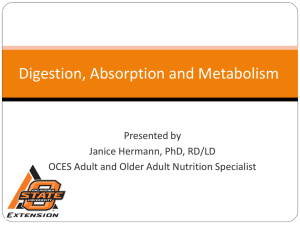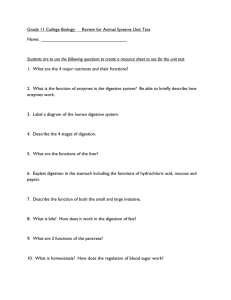I. Cells require many different nutrients
advertisement
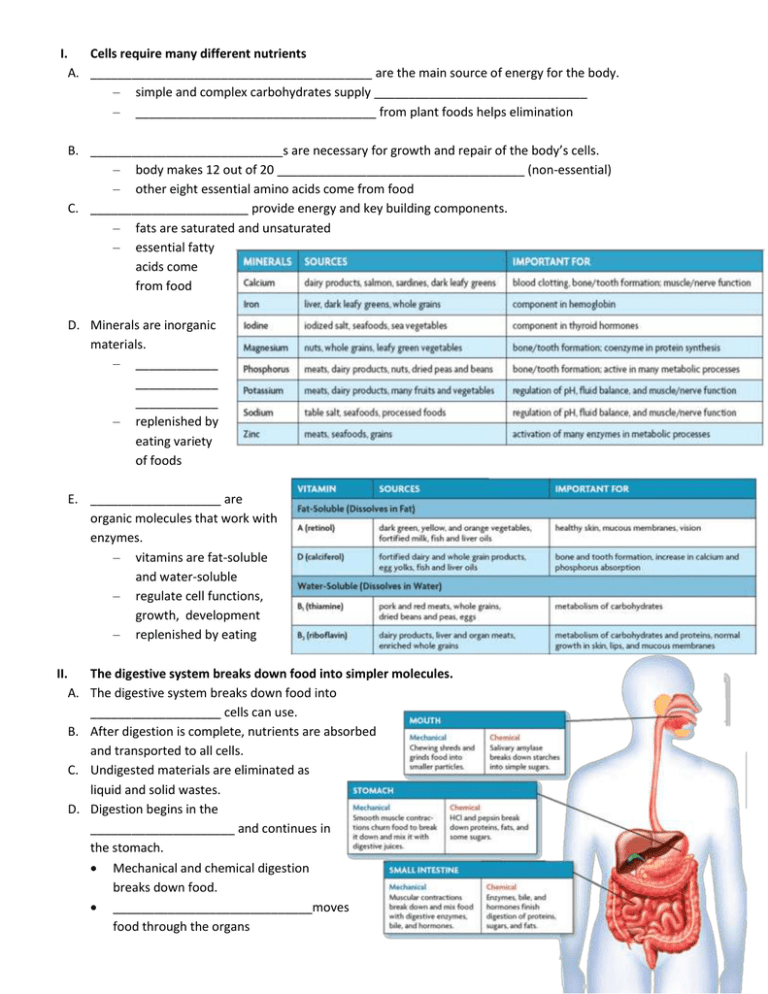
I. Cells require many different nutrients A. _________________________________________ are the main source of energy for the body. – simple and complex carbohydrates supply _______________________________ – ___________________________________ from plant foods helps elimination B. ____________________________s are necessary for growth and repair of the body’s cells. – body makes 12 out of 20 ____________________________________ (non-essential) – other eight essential amino acids come from food C. _______________________ provide energy and key building components. – fats are saturated and unsaturated – essential fatty acids come from food D. Minerals are inorganic materials. – ____________ ____________ ____________ – replenished by eating variety of foods E. ___________________ are organic molecules that work with enzymes. – vitamins are fat-soluble and water-soluble – regulate cell functions, growth, development – replenished by eating II. The digestive system breaks down food into simpler molecules. A. The digestive system breaks down food into ___________________ cells can use. B. After digestion is complete, nutrients are absorbed and transported to all cells. C. Undigested materials are eliminated as liquid and solid wastes. D. Digestion begins in the _____________________ and continues in the stomach. Mechanical and chemical digestion breaks down food. _____________________________moves food through the organs E. F. G. H. I. J. K. L. M. N. O. P. Q. Digestion of _________________________ begins in the ___________________________________________ Digestion of ____________________________________ occurs in the ___________________________. Digestion of______________________ and __________________ occur in the ___________________. Digestion is completed in part of the small intestine. a. Most digestion takes place in the _______________________________________. The pancreas, liver, and gallbladder aid in digestion. a. _______________________________ helps digest fat and protein b. ________________from the liver/gallbladder helps digest fats Saliva contains an enzyme (amylase) Stomach contains pepsin, an enzyme activated HCl ___________________ breaks down proteins to form amino acids Small intestine is 6m long! The pancreas secretes many __________________s to break down nutrients in food ___________________ secretes bile for fat digestion Diarrhea occurs when the muscles are contracting too quickly not enough time for water to be removed from bolus watery stool This is defection. III. Most absorption of nutrients occurs in the ____________________________. A. Three structures in the small intestine help absorb nutrients. a. ________________: adds surface area, slows food b. _____________________: absorb nutrients c. _____________________________: cover villi, absorb nutrients B. _______________________- simple sugars, amino acids, and minerals are absorbed and go to liver C. ______________________ glucose, amino acids, vitamins and water are absorbed and go to body parts D. _______________________ absorb fat soluble vitamins, vitamin B12,, fatty acids, cholesterol . IV. Water is absorbed and solid wastes are eliminated from the large intestine. A. The ___________________________ helps to maintain the body’s fluid balance. B. Undigested material forms the solid feces. – stored in rectum – eliminated through anus V. The excretory system eliminates nonsolid wastes from the body. A. Nonsolid wastes are eliminated through lungs, skin, and kidneys. a. ________________exhale carbon dioxide and water vapor. b. ____________________ in skin release excess water and salts. c. __________________ filter and clean the blood to produce _____________________ B. The kidneys help to maintain homeostasis by filtering the blood. • Kidneys are a pair of bean-shaped organs. – two layers: ____________________________________________ – filtering units called ______________________________________ – renal artery and renal vein C. Kidneys have three basic functions in maintaining homeostasis. – __________________________________________ – help to maintain electrolyte, pH, and fluid balances – release key hormones D. ____________________clean the blood and produce ________________ • ___________________________ are the filtering units in the kidneys. • They clean and rebalance the blood to produce urine. E. Nephrons clean the blood in a three-step process. a. The first step ________________ of the blood. b. The second step is _______________ of materials. c. The third step is ________________ of materials. F. _________________________can be used to filter and clean the blood
